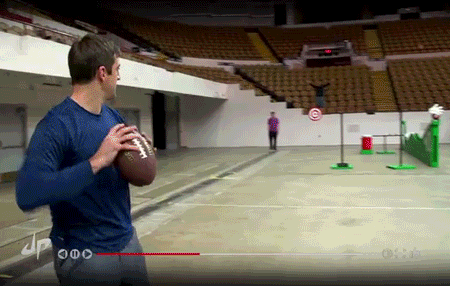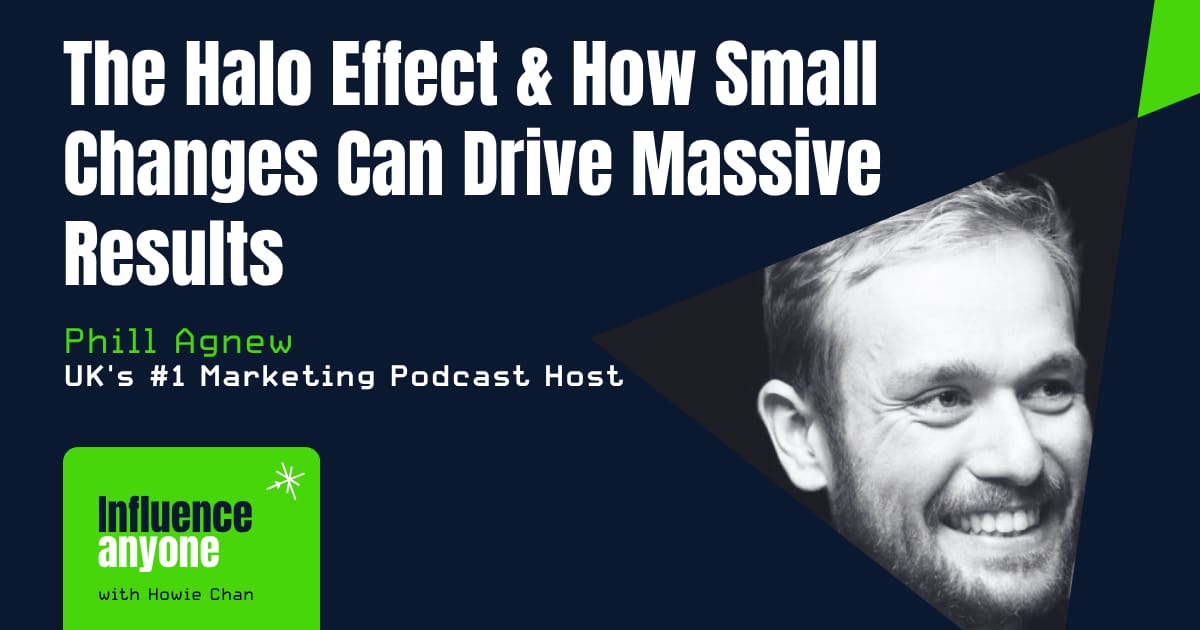Dear {{ first name | Legend}},
have you ever seen a Dude Perfect video? If you have, I’m pretty sure it’s stopped your scroll.
Not because they’re beautiful.
Not because they’re clever.
But because you can feel how much work went into them.
Dude Perfect is the YouTube group famous for throwing ping pong balls into cups across warehouses and making all kinds of impossible shots. 61.7 million subscribers and counting.
Millions of people watch them do something stupidly simple. But the reason those videos hit isn’t the trick shot….

Dude Perfect
When I sat down with Phill Agnew, host of Nudge, UK’s #1 Marketing Podcast, this is what he said:
“This is pure input bias… because what they do not show is just how many attempts they had before they made that trick shot.”
Input bias is the idea that a job that looks effortful becomes more persuasive, more trustworthy, and more valuable than the same job done effortlessly.
Why does this matter?
Because the idea of effort works on everyone.
Which means:
If you deploy visible effort deliberately, you become instantly more persuasive to:
your team
your customers
your investors
your partners
your spouse
your kids
Let’s talk about why.
The Science: Why Visible Effort Multiplies Influence
“The more effort you put into something, the more people value it.”
Phill described a real experiment:
“Presentations were rated as far higher quality when people were told the presenter had spent 8 hours instead of 80 minutes creating it even though the presentation itself was identical.”
He shared another:
“Real estate agents gave clients the same list of houses but when the clients were told the list took all night to prepare, they were far more likely to view them, far more likely to make an offer on them, far more likely to buy them.”
People aren’t just buying the houses.
They’re buying the effort.
Psychologists call this cluster of effects things like:
Input bias / effort heuristic – we use visible effort as a shortcut for quality.
Costly signaling – when something is expensive or effortful to do, it signals sincerity and competence.
Labor illusion – we value services more when we can see the work (even if that work is partially fake).
The IKEA effect – we value things more when we know a lot of work went into them (especially when we did the work).
In a world where AI can generate “good enough” everything, visible effort is becoming the new premium signal.
So let’s use it. Ethically.
The Mindset: Stop Hiding the Sweat
Most of us were trained to hide the work.
“Make it look effortless”
“If you’re good, it should look easy.”
“Don’t bother them with the process, just show the polished thing.”
That’s backwards if you want influence.
New mindset: Effort is part of the message.
If they can’t see your effort, they’ll underestimate your quality, your care, and your commitment.
Now, how do you use this as a leader, founder, marketer, or creator?
Let’s get specific.
Skillset: 7 Situations Where Showing Effort Helps You Win People Over
Think of effort as a multiplier on whatever you’re already doing.
Same pitch + more visible effort = more trust.
Same ask + more visible effort = more yes.
Here are seven scenarios and what “more visible effort” can look like in each.
1. Sales & Pitches: Effort as Proof of Fit
When you’re pitching a client, investor, or partner, they’re running an unconscious script:
“Did you do this just for us, or is this just what you send everyone?”
So show effort by making your work obviously specific:
Custom examples
“On slide 12, we mocked up your actual product page and tested three alternative headlines with 50 people in your target audience.”
Visible iteration
“We explored 5 different pricing models based on your last 18 months of Stripe data and here’s the comparison.”
Pre-work receipts
Screenshots of your whiteboard, Figma explorations, raw spreadsheets. Not to impress with complexity, but to demonstrate, “We sweated this for you.”
Effort doesn’t mean 110-slide decks.
It means the right 12 slides, with sweat stains to prove it!
2. Marketing & Content: Effort as Proof of Authority
Your audience is drowning in content that reads like it was written in 0.7 seconds.
So effort becomes a sharp edge.
Some ways to signal it:
Show your sources
Phill does this with citations at the bottom of his newsletters. It’s not just decoration; it’s a receipt for the effort.
Run real experiments
His shrinkflation episode wasn’t just “here’s a study.” He literally went to Bolton with sliced Warburtons bread to test if locals could detect smaller loaves. That’s effort, and you feel it.
Build “only-we-would-do-this” assets
Industry benchmarks you compiled manually
Teardowns with hours of screenshots and notes
Interactive tools or calculators
Ask yourself: “What could we publish that clearly took more than 10 minutes?”
That’s the thing people will share, trust, and remember.
3. Leadership & Management: Effort as Proof of Care
Employees don’t just follow job titles.
They follow leaders who are working for the privilege to lead.
Work effort like:
Prepared 1:1s
You show up with notes about their recent projects, not “soooo, how’s it going?”
Thoughtful performance reviews
You quote back exact phrases from their work, examples from six months ago. It screams: I’ve been paying attention.
Change communications that show the work
“We spoke to 37 people across CS, Sales, and Product before making this decision. Here’s what they told us and how it shaped our choice.”
The content of your decision and communication matters.
But the visible effort behind it determines whether people go along willingly or resentfully.
4. Product & Service: Effort as Proof of Quality
We all know brands that wear their effort on the label:
“Aged for 12 years.”
“Handmade in small batches.”
“Four years of R&D and 132 prototypes later…”
That’s not just storytelling. It’s costly signaling
“This was expensive and time-consuming to make. We would be insane to put in this much work for something bad.”
In services, “handmade” can look like:
A detailed onboarding questionnaire that clearly took time to design.
A kickoff workshop where you turn up with pre-filled canvases based on their public data.
A “here’s what we did this month” Loom showing what your team actually worked on.
If you’re already doing the work, you might as well get persuasion credit for it.
5. Negotiations & Hard Asks: Effort as Proof of Commitment
When you point effort at a relationship before making a big ask, you’re stacking two biases:
Reciprocity – I want to return the favor.
Input bias – And I especially want to return big favors.
Phill’s reciprocity experiment is such a clean example. He went to ~10 big names in his space, did something unprompted and genuinely helpful for each: promoted their show, newsletter, or launch and only later asked if they’d be willing to promote his episode.
He expected maybe half would say yes.
Eight out of ten did. Many went beyond what he asked (full newsletters, multiple posts).
The important bit:
He didn’t just “like a tweet.”
He invested real effort. That makes not reciprocating feel uncomfortable.
In your world:
Before the big enterprise renewal ask, spend serious effort co-building the roadmap with your champion.
Before pitching a strategic partnership, send 2–3 high-effort intros or custom insights you pulled for their business.
Before asking your team for a brutal crunch week, invest in weeks of thoughtful planning, clear communication, and realistic scoping and show that you did.
People respect what you struggled for.
6. Hiring & Careers: Effort as Proof of Signal
On the candidate side:
A generic CV and “To whom it may concern” cover letter signals: low effort, low intent.
A short Loom walking through why you’re excited about this company, and a small project tailored to their problem, screams: this matters to me.
On the hiring side:
Fast, sloppy processes signal: “We don’t care enough to get this right.”
Clear timelines, tailored questions, thoughtful feedback even for rejected candidates build brand equity because of visible effort.
You’re not just assessing skill.
You’re broadcasting your standards.
7. In the Age of AI: Effort as a Differentiator
This is what we’re up against right now.
As more things become effortless to produce: code, copy, designs, content… effort itself becomes rare.
And rare things become valuable.
You don’t need to suffer publicly. You don’t need to work 80-hour weeks. But for your most important influence moments:
Ship things that clearly required original thinking, not just remixing.
Share small behind-the-scenes glimpses of the messy draft, the failed attempts, the experiments that didn’t work.
Use AI to remove toil where effort isn’t persuasive (scheduling, formatting, note-taking) so you can pour human effort into what is: insight, judgment, care.
The message you want people to receive is: “Other people might automate this.
We chose to care instead.”
Pop Quiz: Which of these biases/ effects are associated with EFFORT?
If you only remember one thing:
Don’t just work hard.
Let your effort be seen where it matters.
Because in a world flooded with quick fixes, fast delivery, showing your effort is going to put you in a different light, one where people feel you truly care.
So I want to share this with you:
I spent 16.5 hours before I hit send on this newsletter issue:
5 hours to prep for Phill’s interview (reading, listening, watching his interviews, articles, social posts etc.)
2 hours to draft questions and arc of the interview
1.5 hours to get ready and perform the interview
6 hours to review transcript, pull out insights and write the email
2 hours to create additional assets from the interview
(check out 10 brain hacks you can use to influence anyone - 7,316 people are already using it!)
Forward this newsletter to someone who’d enjoy it!
If you like this issue about the science of effort, you’ll love:
The Everyday influence Playbook From The Godfather of Influence (Six Strategies)
The Shortcut to Getting Chosen (Without Outperforming Anyone)
They Said Yes Before He Even Spoke. Here’s How. (The T.I.M.E model for Pre-Suasion)
Change behavior, change lives 🤘🏽
Howie Chan
Creator of Influence Anyone
Don’t miss:
The Influence Anyone Podcast
In this conversation, Nudge podcast host Phill Agnew reveals why humans are influenced not by logic, but by the effort they believe went in behind the scenes.
He takes you inside his real experiments: from carving slices out of Bolton’s favorite bread to test shrinkflation, to running five studies that toppled big claims in Thinking, Fast and Slow, to the reciprocity test that got world-class psychologists saying yes without even realizing why.
You’ll walk away with the psychology most people never notice but are influenced by every day.

